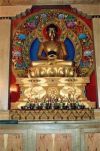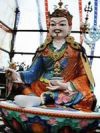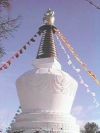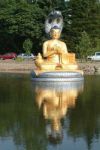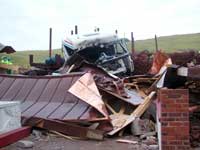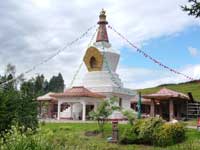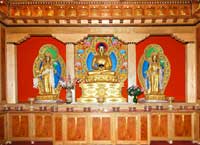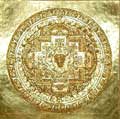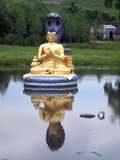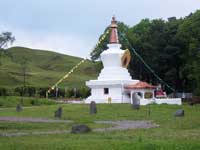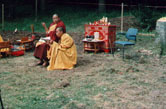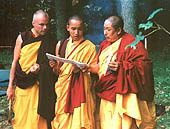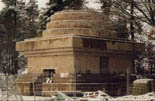| Samye Ling Stupa Archive |
|
SCOTTISH
PROJECTS THE
HERITAGE PROJECT IN TIBET TIBETAN
HERITAGE Tibet's Geographic Importance to the Global Environment
|
|
|
|
|
|
|
Past Article: Tibet's
Geographic Importance to the Global Environment |
2007 The Prayer Wheel House standing on three sides of the beautiful Samye Ling Victory Stupa, was consecrated in a traditional ceremony by Akong Tulku Rinpoche in the Summer of 2007. Each Prayer Wheel contains millions of prayers. The energy and blessing of these prayers is activated and sent into the environment by the wheels turning. Electric Motors turn the wheels very slowly so that the prayers are continuously transmitted day and night, but individual pilgrims can turn the wheels by hand as each one has a beautifully turned wooden handle. They then gain the merit of saying these millions of prayers for all beings and the planet itself. Samye
Ling Stupa |
|
|
2006 The Prayer Wheel House Logging
Lorries The
Stupa The
Fountain of Blessings |
||
 |
During August Rokpa Heritage Project organised a "Buddhist Himalaya" festival to support and protect endangered Himalayan culture in Tibet and Nepal at Rheged Mountaineering Centre Nr Penrith. It featured lectures and a photographic exhibition by famous explorers and mountaineers, talks, workshops and videos on Himalayan culture, meditation, medicine art and spirituality, Himalayan film festiva,l Himalayan market and book fayre and Tibetan dance performances featuring Dolkar Lhamo and Tashi Dorje. We would like to thank all our evening speakers, particularly Sir Chris Bonington, Doug Scott CBE, Mike Searle from Oxford University and Julian Freeman -Atwood. Rokpa thanks Rheged, and the companies that helped to sponsor the Exhibition. |
|
2005 December On the morning of December 9th an unladen logging lorry skidded on some black ice on the narrow valley road that passes Samye Ling, careered through the hedge into the prayer wheel house and brought the whole structure down. Amazingly, no one was killed and the Stupa was not damaged. more pictures and information |
||
|
August
|
||
|
During the summer of 2005 more than 60 volunteers arrived each weekend to help build the Prayer Wheel House. Akong Tulku Rinpoche worked alongside us every day and often gave impromptu teachings during the group tea breaks. Amazing progress was made with a small group of volunteers working alongside a team of residents every week day from eight in the morning until ten or 11 at night. It was an unusually hot summer with week after week of good weather and the atmosphere was joyful and harmonious. See Pictures The walls and roof trusses were built and the inner walkway paved. By the end of July all that needed to be done before the installation of the prayer wheels was the fixing of sandstone . Meanwhile prayer wheels were being filled with millions of mantras, painstakingly saffroned, rolled and blessed. A self taught Mani Wheel engineer had been working all summer experimenting with rods and cogs and electrical ideas to create super smooth turning wheels. During the autumn the copper roofing was completed and the sandstone sills fixed in place ready for the prayer wheels to be installed by skilled volunteers who worked at weekends.
|
||
| Prayer Wheel House: It's April and the foundations have begun. Many prayer
wheels have been sponsored as has the copper for the roofing and the
building materials for the retaining wall. Around £50,000 is
still required for the foundations, wooden roof struts and glass inner
wall. The building work is being carried out by dedicated volunteers
in their spare time. The approach path wil be completed and landscaped
with rabbit-proof bulbs and shrubs this autumn. More
aout the Mani Korlo House |
||
|
2004 Progress on the Stupa Interior: Master Joiner Steven Harting has fitted the panelled ceiling with a golden inlaid Mandala. Air conditioning is now in place. The floor and inlaid marble mandala, lighting for cabinets, and carved entrance doors will be the next step. We hope to raise the £4,000 needed to complete this next stage this year. |
||
|
2003 Peace Garden Completion: The remaining landscaping tasks for
the Peace Garden were completed, a major part of this being the
construction of the Nagarjuna statue in the large Lotus pond by
Lama Thubten Kunsal, with help from the venerable Gyamtso, Gelong
Lamzang and Namdrol. The statue faces West and symbolises the establishment
of the Mahayana teachings on Wisdom and Compassion in the West.
The Copper entrance canopy to the Stupa was completed just in time
for the Summer Tea Party. Jimpa returned once again to renew work
in the shrine room. |
||
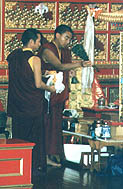 |
2002 Mingyur Dorje Rinpoche: At the end of 2002 Rinpoche
came to Samye Ling to confer empowerments and to conduct a Drupcho
to clear away obstacles to peace and harmony in the world. During
this time he consecrated the ashes of those who had chosen the Stupa
to be their final resting place.
|
|
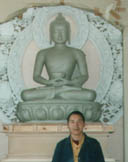 |
Inner & Outer Work: Lama Thubten Kunsal came all the way from Tibet from his Monastery, Tashi Gonsar Gong monastery in Dege, East Tibet. He completed the most beautiful statue of Amitabha, Vajrapani and Chenrezig, all 3 statues are more than life size for the Stupa shrine. Before the Autumn he also completed a magnificent statue of Guru Rinpoche seated on a lotus in the middle of the fountain of blessings outside the Stupa. During the Spring and Summer the bridge between the island and the Stupa was completed as well as the painting of the Stupa in white. Jimpa came during the year to begin the work of fitting out the Amitabha Shrine in the Stupa. The woods used will be native; Oak, Cherry, Yew, Sycamore and Ash and there is no doubt in everyones mind that this will be the most beautiful Stupa in the World. |
|
 |
2001 Nyamso: Akong Rinpoche chose a new name "Nyamso" for the fundraising treks. Nyamso means "To Restore". The newly designated Pilgrimage Treks support the Stupa Project in the West and similar projects in Tibet. Mount Kailash The first of these pilgrimage treks set off for Mount Kailash and a very seldom visited area called Kyirong (the site of Milarepa's long mountain retreat at Drakar Taso) in May 2001 during the Holy month of Saga Dawa. |
|
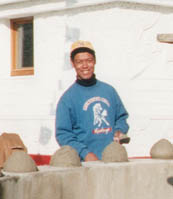 Karpu |
Decorating the Stupa and Planning the Peace Garden: Karpu,
a master stupa carver from Nepal, came to decorate the basic structure
with wonderful traditional relief carving. Chenden began to work with
Jimpa, a carpenter and artist who had been a monk on Holy Island,
designing the panelling for the inner shrine of the Stupa. More fundraising
was initiated to complete the stupa, establish the Peace Garden and
build the bridge and Guru Rinpoche Fountain, which are part of the
Garden. Two trekkers, Will Tooby and Jane Cox, who are nursery gardeners,
undertook to gather plants and deliver them according to plans made
by Betty and Paul Richardson who designed the garden and pond in consultation
with Akong Rinpoche. Vin Harris, an ex- resident of Samye Ling, who
runs a woodworking business in the valley, undertook to fund the wood
panelling for the Amitabha Project which provides funeral arrangements
and boxes for ashes to be placed inside the Stupa. |
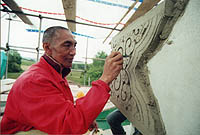 Venerable Gyampso
|
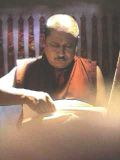
Lama Phuntsok |
2000 Stupa Consecration Lama Phuntsok arrived in summer with a bevy of young monks to conduct the purification and blessing of all the stupa's contents. On August 3rd, Dharmachakra Day, the great ceremony of consecration was conducted by Sangye Tenzin Rinpoche, one of Tibet's greatest saints and masters in the company of a great gathering of lamas, monks, nuns and lay followers.
|
|
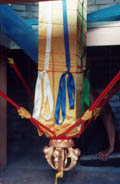
|
The Spire
The inner form of the Spire was made from solid concentric circles
of Douglas Fir, then taken to Oxford to be covered with copper. The
thirteen rings of the spire represent the 13 levels of Spiritual Achievement
and Teaching of the Bodhisattvas (great enlightened beings of compassion
and wisdom). The Life Stick was then craned into place in a moving
ceremony on a beautiful sunny afternoon. Held in place with red and
yellow climbing ropes above a golden mandala, it forms the inner backbone
of the sacred structure. It is sealed into the structure with all
the sacred texts and other ritual objects. The golden canopy, sun
and moon ornaments, symbolise the pinnacle of this path, the perfection
of Wiosdom and Compassion, the Buddha Mind. |
 |
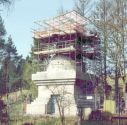 |
The Bumpa: The Bumpa or 'Vase' is the second hollow chamber and symbolises Emptiness and Compassion. Architect Chenden designed the Bumpa and led the building team to Victory with Terry Mills taking care of health and safety. Terry was a great benefactor who donated lorry loads of bricks and tools from the start of the project. He came nearly every weekend to help with the concrete pouring, now it was a race to finish for the August consecration. |
|
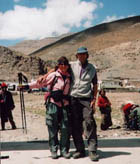
|
Fundraising Treks Begin: In February the fundraising treks took place providing the much needed funds for the continuation of building work on the Victory Stupa. Work proceeded on the construction of the bumpa under the guidance and supervision of Chenden, a monk who is an architect and who helped considerably with the building work. |
|
|
|
1999 Millenium Himalayan Challenge: It was clear that large funds would be needed to complete this ambitious project, so a meeting of the Stupa Committee was called for ideas and support. Sir Chris Bonington, Doug Scott, Hamish McInnes, all mountaineers familiar with and supportive of Tibetan culture, gathered to consult and advise. Doug Scott and Hamish McInnes had been given Tibetan texts describing the sacred aspects of the valleys of Nepal. Doug suggested organising fundraising treks to the caves and valleys which had been the retreats of great Tibetan meditators in Nepal. With his help and support three treks were organised raising altogether £90,000 towards the building of the stupa
|
|

|
1998 The Fundraising Exhibition: The exhibition of donated art works opened on May 9th at St. Mungo's Museum and lasted for one week. It was supported by The Bank of Scotland, Glasgow Museums, Carruthers Gemmil, Dumfries and Galloway Council and the building firms, Ove Arup and Miller Constructions. The Exhibition began with a combined Scottish and Tibetan musical performance in front of Glasgow City Chambers. The Selkirk Pipe Band played in concert with Tibetan instruments of the Sangha of Samye Ling and a display of Tibetan Sacred dance. Artists, photographers and crafts men from all over the world contributed to the Exhibition. Notable Scottish artists included Andy Goldsworthy, Stephen Campbell and Craigie Aitchison. |
|
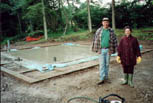
|
Foundation laid: Work began on laying the reinforced
concrete foundations of the Victory Stupa at Samye Ling. Throughout
the summer volunteers gathered at weekends to help with concrete pouring
and bricklaying. By the end of 1998 we had built the shrine room.
Work continued through 1999 and by the end we had constructed the
4 rings which form the walls of the first hollow chamber and symbolise
the four immeasurable thoughts of Loving Kindness, Comapassion, Joy
and Impartiality. These were completed by the winter. |
|
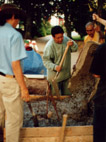 Pouring Concrete |
1997 The building of the small Stupas: Akong Rinpoche initiated the building of 8 small Stupas in the Samye Ling drive to introduce the concept of Stupa's to the community. This gave a great boost to the fund-raising process and educated us all in the process of Stupa building and its practical and spiritual significance. Blessing the Land: The area on which the stupa would be built was consecrated in the presence of Akong Rinpoche, Lamdrak Rinpoche and Lama Phuntsok. |
|
1996 International Support: Messages of support for the Stupa Project were sent from the Office of the Prince of Wales, President Mandela and Archbishop Tutu. Professor Keith Critchlow of the Prince of Wales's School of Architecture, Sir Chris Bonington CBE, Jimmy and Sarah Boyle of the Gateway Trust and Doug Scott CBE were among other notable supporters of the project. |
||

|
1989
Beginning of Project: By this time the site of the Peace Stupa at Samye Ling was chosen, consecrated and blessed by Situ Rinpoche and Pawo Rinpoche. Previosly in 1984 the Dalai Lama on his first visit to Samye Ling blessed the area around the future Stupa as a World Peace Garden. |
|
